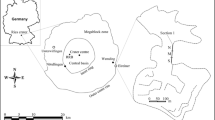Abstract
The elastic properties of a physical model representing a damaged rock matrix were studied using a square lattice deformed under tensile stress. The elastic modulusM of such a system varies in agreement with percolation theory as|x−x c |f, wherex is the damage parameter andx c the threshold value of the damage parameter,f≃3.6. Atx≃x c the scale dependence ofM can be expressed asM∼L −f/v, whereL is the size of the sample andv the correlation exponent in percolation theory.
The experimental results are of interest in assessing elastic properties in earthquake focal zones and fault zones in general.
Similar content being viewed by others
References
Benguigui, L. (1984),Experimental Study of the Elastic Properties of a Percolating System, Phys. Rev. Lett.53, 2028–2030.
Bergman, D. J. (1985),Elastic Moduli near Percolation, Phys. Rev.B 31, 1696–1699.
Chelidze, T. L. (1985),Percolation Theory and Failure Criterions, Uspekhi Mekhaniki, Warsaw,8 (2), 39–55 (in Russian).
Chelidze, T. L. (1986),Percolation Theory as a Tool for Imitation of Fracture Process in Rocks, Pure Appl. Geophys.124, (4/5), 731–748.
Chelidze, T. L. (1987),Percolation Theory in Rock Mechanics, Moscow, Nauka, 136 pp. (in Russian).
Chelidze, T. L., Gueguen, V., Darot, M., andRoechle, T. (1988),On the Elastic Properties of Depleted Refilled Solids near Percolation, J. Phys.C21, L1007-L1010.
Christensen, R. M.,Mechanics of Composite Materials (Wiley 1979) 330 pp.
De Gennes, P. G. (1976),On a Relation Between Percolation Theory and the Elasticity of Gels, J. Physique Lett.37, L1-L2.
Feder, T.,Fractals (Plenum, N.Y., London 1987).
Hill, R. A. (1965),A Self-consistent Mechanics of Composite Materials, J. Mech. Phys. Solids.13, 213–223.
Kirby, S. H., andScholz, C. H. (1984), Spec.Issue onChemical Effects of Water on the Strength and Deformation of Crustal Rocks, J. Geophys. Res.89, B6.
Maxwell, G. C.,A Treatise on Electricity and Magnetism, vol. 1 (Oxford 1904).
Petrov, V. A.,The basis of the kinetic theory of failure and its prediction, InEarthquake Prediction No. 5 (Dunshanbe-Moscow 1984) pp. 30–45 (in Russian).
Roux, S., andGuyon, E. (1985),Mechanical Percolation: A Small Beam Lattice Study, J. Phys. Lett.46, L999-L1004.
Sahimi, M. (1986),Relation Between the Critical Exponents of Elastic Percolation Networks and Conductivity and Geometrical Exponent, J. Phys.C19, L79-L83.
Stauffer, D.,Introduction to Percolation Theory (Taylor and Francis 1985), 124 pp.
Author information
Authors and Affiliations
Rights and permissions
About this article
Cite this article
Chelidze, T.L., Spetzler, H., Getting, I.C. et al. Experimental investigation of the elastic modulus of a fractal system—A model of fractured rocks. PAGEOPH 134, 31–43 (1990). https://doi.org/10.1007/BF00878078
Received:
Revised:
Accepted:
Issue Date:
DOI: https://doi.org/10.1007/BF00878078




